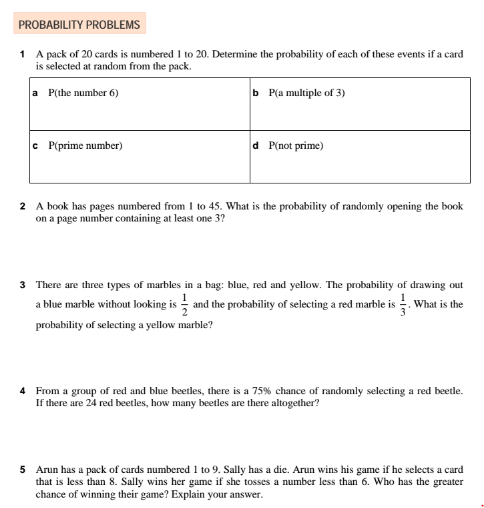(1) - As pack contains cards numbered #1# to #20#, if a card is selected at random, all have equal probability of being selected and probability of each is #1/20#. As such probability of getting #6# is #1/20#. We get a multiple of #3#, when we get #{3,6,9,12.15.18}# and hence probability of getting a multiple of #3# is #6/20=3/10#. Prime numbers between #1# and #20# are #{1,2,3,5,7,11,13,17,19}# and hence probability of getting prime numbers is #9/20#. It is apparent from this that probability of not getting a prime is #11/20#.
(2) As book is page numbered #1# to #45#, odd numbers will appear on left hand side and even on right hand side and it could open at 1 or 2-3 or 4-5 and so on and lastly 44-45 - #22# possibilities. #3# will appear when we get 2-3, 12-13, 22-23, 30-31, 32-33, 34-35, 36-37, 38-39 and 43-44 and probability of appearing a page number containing #3# will be #9/22#.
(3) As probability of getting a blue marble is #1/2# and getting a red marble is #1/3#, the probability of getting a yellow marble is #1-1/2-1/3=1/6#
(4) As among red and blue beetles, there is a #75%=3/4# probability of randomly selecting a red beetle and there are #24# red beetles, we have #100%-75%=25%# blue beetles and there number will be #24/3=8# (as #25%# is one-third of #75%#) and we have #24+8=32# beetles altogether.
(5) As the cards are numbered 1 to 9 and there are 9 possibilities, getting less than 8 means getting 1 to 7 and probability of Arun getting it is #7/9#. Sally loses if she gets less than 6 on die and as a die contains six faces numbering 1 to 6, probability of Sally loosing is #5/6# and she has #1/6# chance of winning. Hence, Arun has greater chance of winning game.

